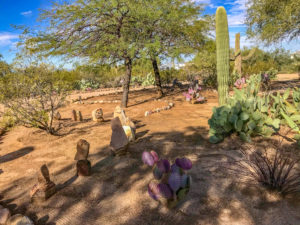
Secure in the beautiful landscaping of brother Phil Miller, we busied ourselves with projects and activities that reacquainted us with the beautiful Sonoran Desert. Phil’s 1 acre is minutes away from Saguaro National Park’s western unit, and features a 360° panorama of southern Arizona’s predominant mountain ranges: the Tucson Mountain range featuring Mt. Wassen to the east, the West Silver Bells to the west, and the Roskruge mountains in the southwest. From the end of his driveway, one can get a glimpse 9,157′ Mt Lemon looking down on Catalina State Park in the northwest corner of Tucson. Years earlier we’d hiked with Phil up the Hugh Norris trail to a budding Palo Verde tree that shared the lookout over the Picture Rocks section of Tucson. After descending, we returned to our wonderful dog, Gooper, who was prohibited from joining us in the National Park. While we were away, he’d cozied himself beneath Phil’s deck and befriended a Diamondback Rattlesnake. Both evidently tired of staring each other down, and it was our panic that resulted in a Park herpetologist driving over to calmly remove the snake.
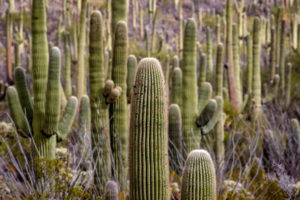
Nothing that dramatic occurred this visit, and we walked the ravine behind the Visitor’s Center where a Cactus Wren completely ignored us while scratching aside pebbles for tasty morsels. We were unprepared for what happened next: the precocious bird moved into the parking lot and jumped up onto car bumpers looking for bugs. We then drove deeper into the park to Signal Rock where ancient Hohokam people chipped away the patina of smooth rocks, leaving designs called “petroglyphs” for future generation’s enjoyment.
Madera Canyon, a favorite camping destination and fabulous birding environment, lies 12 miles east of Green Valley. It’s an easy hour and change south of Tucson on Hwy. 19, and after a few days with Phil we headed south see what we’d missed from our visit the previous year. Arriving on a Sunday afternoon, we had little trouble securing a campsite in the Bogs Springs Campground in Madera Canyon. Camping fees are $10/night and for holders of the interagency “Old Fart’s” pass, that’s reduced to $5/night. Furthermore, the day use fee throughout Madera Canyon is waived as long as the Senior Pass is displayed on your car’s dashboard.
Phil pined in with where that term originated. In the days of horse and wagons, the rider would sit on a bench and there was a diagonal board on which they’d place their feet. It was not just for driver comfort, however, but for when the horses were “dashing” it protected the operators from mud thrown by their mighty steeds. Other carryovers from years past are the name of a bicycle seat more commonly called a saddle, and that wealth of yummy treats for that Canyon Wren, a car’s undercarriage.
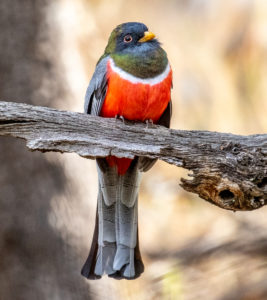
Click for a larger image.
The principal target bird for every birder is the Elegant Trogon, and we were fortunate to spot one while hiking the canyon. By one account, there are only a couple hundred of the birds in Southern Arizona, its northernmost range from its more typical habitat in Northern Mexico. They’re very difficult to see because they perch silently and slowly scan the area for food. We observed it suddenly drop into tall grasses and return to the same branch with a juicy worm. The bird we found remained in the Madera Canyon drainage and hunted an approximately 100 yard stretch of the creek without apparent concern for bystanders. An hour earlier about 20 noisy hikers passed by and hardly phased the bird. But then there are days when NO ONE sees the bird and we’ve had plenty of those days. A really good sport is one driven by unpredictability, and birding fills our bill.
Another surprise sighting at this elevation (4,900′ – 1,500 m) was a rare bird called an Olive Warbler. Only, it’s not a warbler at all and is placed in its own family. The bird is relatively common in high mountains of Central America and Mexico, but its northernmost range into Southern Arizona is limited, probably due to logging of its most common habitat, pine forests. So what a coincidence we saw both a female and a male in some oaks and sycamores common to the canyon. Its companions were several Kinglets, a Bridled Titmouse, and White-breasted Nuthatches, all collectively flitting about searching for food.
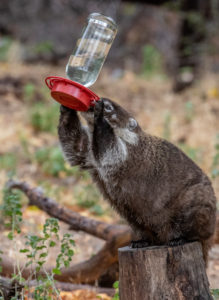
The dawn of our 3rd day, Thanksgiving, began with nearly pea-sized raindrops plummeting our trailer. We hunkered down with a good read and our trusty furnace. After breakfast, the rain let up and we donned weather gear for a hike to the canyon. There’s a .6 mile trail from Bog Springs CG that connects with the park amphitheater, and from there we strolled down the canyon to the Santa Rita Lodge to see what the feeders brought in. There was a beautiful Hepatic Tanager in the trees above the feeders that thoughtfully posed while munching on berries. What proved more entertaining was a Coatimundi balancing on a tree round while chugging the entire contents of a hummingbird feeder. A lodge employee explained that they position that particular feeder just for the long-tailed critters so they leave the other feeders alone.
Our final night in Bog Springs was particularly memorable due to an extreme winter storm that blew in from seemingly everywhere. We’d taken a walk after our Thanksgiving feast of Chili Size (feel free to ask for the recipe). Gusts of wind kept us bundled together as we looped the campground before retiring inside to another game of Cribbage. Soon after, those gusts became stronger. Concerned, we mentally went through the outside shut-down procedure and were confident that everything was secure. Soon after snuggling beneath our comforter, the rain began, and combined with (what we later learned were) 30-40 mph winds, our windows were being hit with considerable force. So there we were, eyes wide open and hoping our new trailer was built to withstand gusts of up to 60 mph. It was difficult sleeping, yet we both dozed off. Now and again we’d awaken after a particularly strong gust, accompanied by a furious roar not unlike what I recalled from my typhoon experience in the Peace Corps. You could hear is coming from a distance, louder, louder, and then WHAM! Pretty darn scary, to be honest. I was particularly grateful for the quality of our trailer, the securely attached solar and AC mounted on the roof, and the stabilizers that were set at all four corners. Nevertheless, our wee home rocked with the best of them. Had we been in our pop-up camper, we’d long earlier dropped the lid for an uncomfortable night. Our dear camping friends who continue to roam in their truck campers would also have been pretty seasick before long having to rely on the shocks of their pickups for stability. At one point, I heard a metallic clank that really got me worried, but there was no way I was stepping out into that storm. The following morning I thankfully discovered it was the carabiner attached to our astro-turf door mat that ended up in a ditch on the other side, striking one of the stabilizers en-route. Lesson learned.
Years ago we visited the Nature Conservancy’s Sonoita-Patagonia Preserve. We met a nice couple who’d volunteered for a spell, and since then we’ve fantasied about volunteering for an extended period someplace to really familiarize ourselves with local wildlife. So we communicated with the resident manager at The Nature Conservancy Preserve and drove the 1½ hours to Patagonia for a visit. The job is a snap: Sooney and I both have qualifications (leading birding and photography groups) and there are some minimal office tasks. He surprised us when he said boredom is the predominant pastime. During peak birding seasons, however, we’ll have plenty of interaction with other birders—all those new best friends will occupy more than our allotment of free time. The expected volunteer gig is 3 months from mid-January to mid-April, and the refuge gates close at 4pm leaving us plenty of daylight to explore the 800+ acres. We anticipate hosting many guests joining us in their RVs.
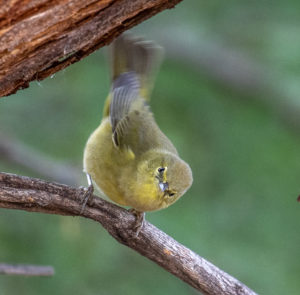
With the replacement of our beloved (and obsolete) Four-wheel camper with our new Escape 21 trailer, we’ve now got the shelter requirement for a potentially lengthy road trip and/or volunteer gig. On this and an earlier fall trip to Great Basin National Park we’ve made a conscious effort to lengthen our stays in locations so as to really dive in to local amenities. Our trip to Patagonia was far easier leaving our trailer behind. Since we’d be in Arizona until mid-April, our next visit would most likely be Sunny Flat Campground and the birdy Cave Creek flowing nearby. We could easily hang out in the Chiricahuas for a couple weeks. There are other great birding hotspots in SE Arizona including Ramsey Canyon and the San Pedro River basin—so much to see, do, and stay healthy for.
Birds seen during this leg of the journey: Wild Turkey, Red-tailed Hawk, Western Screech Owl, Rivoli’s Hummingbird (formerly Magnificent), Elegant Trogon, Acorn Woodpecker, Arizona Woodpecker, Gila Woodpecker, Northern Flicker, Hutton’s Vireo, Mexican Jay, Common Raven, Bridled Titmouse, Verdin, White-breasted Nuthatch, Brown Creeper, Bewick’s Wren, Ruby-crowned Kinglet, Hermit Thrush, Phainopepla, Olive Warbler, Spotted Towhee, Rufous-crowned Sparrow, Dark-eyed Junco, Yellow-eyed Junco, Hepatic Tanager, House Finch, Pine Siskin, Lesser Goldfinch
